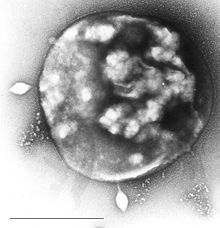Sulfolobus tengchongensis spindle-shaped virus: Difference between revisions
m convert special characters (via WP:JWB) |
No edit summary |
||
| Line 10: | Line 10: | ||
}} |
}} |
||
'''Sulfolobus tengchongensis spindle-shaped virus 1'''(''' |
'''Sulfolobus tengchongensis spindle-shaped virus 1''' ('''STSV1''') is a [[DNA virus]] of the family ''[[Bicaudaviridae]]''. It infects the [[hyperthermophilic]] [[archaeon]] ''[[Sulfolobus|Sulfolobus tengchongensis]]'' which can be found in the volcanic area of [[Tengchong]], [[Baoshan City]], in western [[Yunnan]] province, [[People's Republic of China]].<ref>{{cite journal |vauthors=Xiang X, Chen L, Huang X, Luo Y, She Q, Huang L |title=Sulfolobus tengchongensis spindle-shaped virus STSV1: virus-host interactions and genomic features |journal=J. Virol. |volume=79 |issue=14 |pages=8677–86 |year=2005 |pmid=15994761 |doi =10.1128/JVI.79.14.8677-8686.2005 |pmc=1168784}} Alternatively: [https://www.ncbi.nlm.nih.gov/pubmed/15994761 PubMed], [https://www.researchgate.net/publication/7748977_Xiang_X_Chen_L_Huang_X_Luo_Y_She_Q_Huang_L_Sulfolobus_tengchongensis_spindle-shaped_virus_STSV1_virus-host_interactions_and_genomic_features_J_Virol_79_8677-8686 ResearchGate]</ref><ref>[https://www.uniprot.org/taxonomy/285013 Uniprot Taxonomy: Sulfolobus virus STSV1]</ref> |
||
In 2014, Sulfolobus tengchongensis spindle-shaped virus 2 (STSV2), a relative of STSV1, also infecting ''S. tengchongensis'', has been reported.<ref>{{cite journal |last1=Erdmann |first1=S |last2=Chen |first2=B |last3=Huang |first3=X |last4=Deng |first4=L |last5=Liu |first5=C |last6=Shah |first6=SA |last7=Le Moine Bauer |first7=S |last8=Sobrino |first8=CL |last9=Wang |first9=H |last10=Wei |first10=Y |last11=She |first11=Q |last12=Garrett |first12=RA |last13=Huang |first13=L |last14=Lin |first14=L |title=A novel single-tailed fusiform Sulfolobus virus STSV2 infecting model Sulfolobus species. |journal=Extremophiles : life under extreme conditions |date=January 2014 |volume=18 |issue=1 |pages=51-60 |doi=10.1007/s00792-013-0591-z |pmid=24163004}}</ref> Besides ''S. tengchongensis'', STSV2 infects ''Sulfolobus islandicus'' REY15A. It has been demonstrated that STSV2 induces unprecedented gigantism of ''S. islandicus'' cells by blocking the expression of the cell division genes and arresting the cell cycle in the S phase.<ref name="Liu2021PNAS">{{cite journal |last1=Liu |first1=J |last2=Cvirkaite-Krupovic |first2=V |last3=Baquero |first3=DP |last4=Yang |first4=Y |last5=Zhang |first5=Q |last6=Shen |first6=Y |last7=Krupovic |first7=M |title=Virus-induced cell gigantism and asymmetric cell division in archaea. |journal=Proceedings of the National Academy of Sciences of the United States of America |date=2021-04-13 |volume=118 |issue=15 |doi=10.1073/pnas.2022578118 |pmid=33782110 |url=https://www.pnas.org/content/118/15/e2022578118}}</ref> The diameter of infected cells increases up to 20 times, resulting in 8,000-fold increase in volume compared to noninfected cells.<ref name="Liu2021PNAS" /> |
|||
==References== |
==References== |
||
Revision as of 20:13, 21 June 2021
| Sulfolobus tengchongensis spindle-shaped virus | |
|---|---|

| |
| Electron micrograph of Sulfolobus infected with Sulfolobus virus STSV1. Bar = 1 μm. | |
| Virus classification | |
| Group: | Group I (dsDNA)
|
| Order: | Unassigned
|
| Family: | |
| Genus: | not assigned
|
| Species: | Sulfolobus tengchongensis spindle-shaped virus 1
|
Sulfolobus tengchongensis spindle-shaped virus 1 (STSV1) is a DNA virus of the family Bicaudaviridae. It infects the hyperthermophilic archaeon Sulfolobus tengchongensis which can be found in the volcanic area of Tengchong, Baoshan City, in western Yunnan province, People's Republic of China.[1][2]
In 2014, Sulfolobus tengchongensis spindle-shaped virus 2 (STSV2), a relative of STSV1, also infecting S. tengchongensis, has been reported.[3] Besides S. tengchongensis, STSV2 infects Sulfolobus islandicus REY15A. It has been demonstrated that STSV2 induces unprecedented gigantism of S. islandicus cells by blocking the expression of the cell division genes and arresting the cell cycle in the S phase.[4] The diameter of infected cells increases up to 20 times, resulting in 8,000-fold increase in volume compared to noninfected cells.[4]
References
- ^ Xiang X, Chen L, Huang X, Luo Y, She Q, Huang L (2005). "Sulfolobus tengchongensis spindle-shaped virus STSV1: virus-host interactions and genomic features". J. Virol. 79 (14): 8677–86. doi:10.1128/JVI.79.14.8677-8686.2005. PMC 1168784. PMID 15994761. Alternatively: PubMed, ResearchGate
- ^ Uniprot Taxonomy: Sulfolobus virus STSV1
- ^ Erdmann, S; Chen, B; Huang, X; Deng, L; Liu, C; Shah, SA; Le Moine Bauer, S; Sobrino, CL; Wang, H; Wei, Y; She, Q; Garrett, RA; Huang, L; Lin, L (January 2014). "A novel single-tailed fusiform Sulfolobus virus STSV2 infecting model Sulfolobus species". Extremophiles : life under extreme conditions. 18 (1): 51–60. doi:10.1007/s00792-013-0591-z. PMID 24163004.
- ^ a b Liu, J; Cvirkaite-Krupovic, V; Baquero, DP; Yang, Y; Zhang, Q; Shen, Y; Krupovic, M (2021-04-13). "Virus-induced cell gigantism and asymmetric cell division in archaea". Proceedings of the National Academy of Sciences of the United States of America. 118 (15). doi:10.1073/pnas.2022578118. PMID 33782110.
External links
- Song L, Wang H, Wang S, Zhang H, Cong H, Huang L, Tien P (2014). "Self-assembled bionanoparticles based on the Sulfolobus tengchongensis spindle-shaped virus 1 (STSV1) coat protein as a prospective bioscaffold for nanotechnological applications". Extremophiles. 18 (4): 745–54. doi:10.1007/s00792-014-0655-8. PMID 24903702.
- UCSC Sulfolobus virus STSV1 Genome Browser Gateway
- ENA Genomes Pages - Archaealvirus STSV-1, also STSV-2, and Sulfolobus spindle-shaped virus 1, 4, 5, 6, 7 as well
- NCBI: Sulfolobus tengchongensis spindle-shaped virus 1 (STSV-1) (unclassified species)
- NCBI: Sulfolobus spindle-shaped virus 1 (SSV1) (species, CTV accepted) of genus Alphafusellovirus, family Fuselloviridae — not to be confused (see also UniProt: SSV1)
